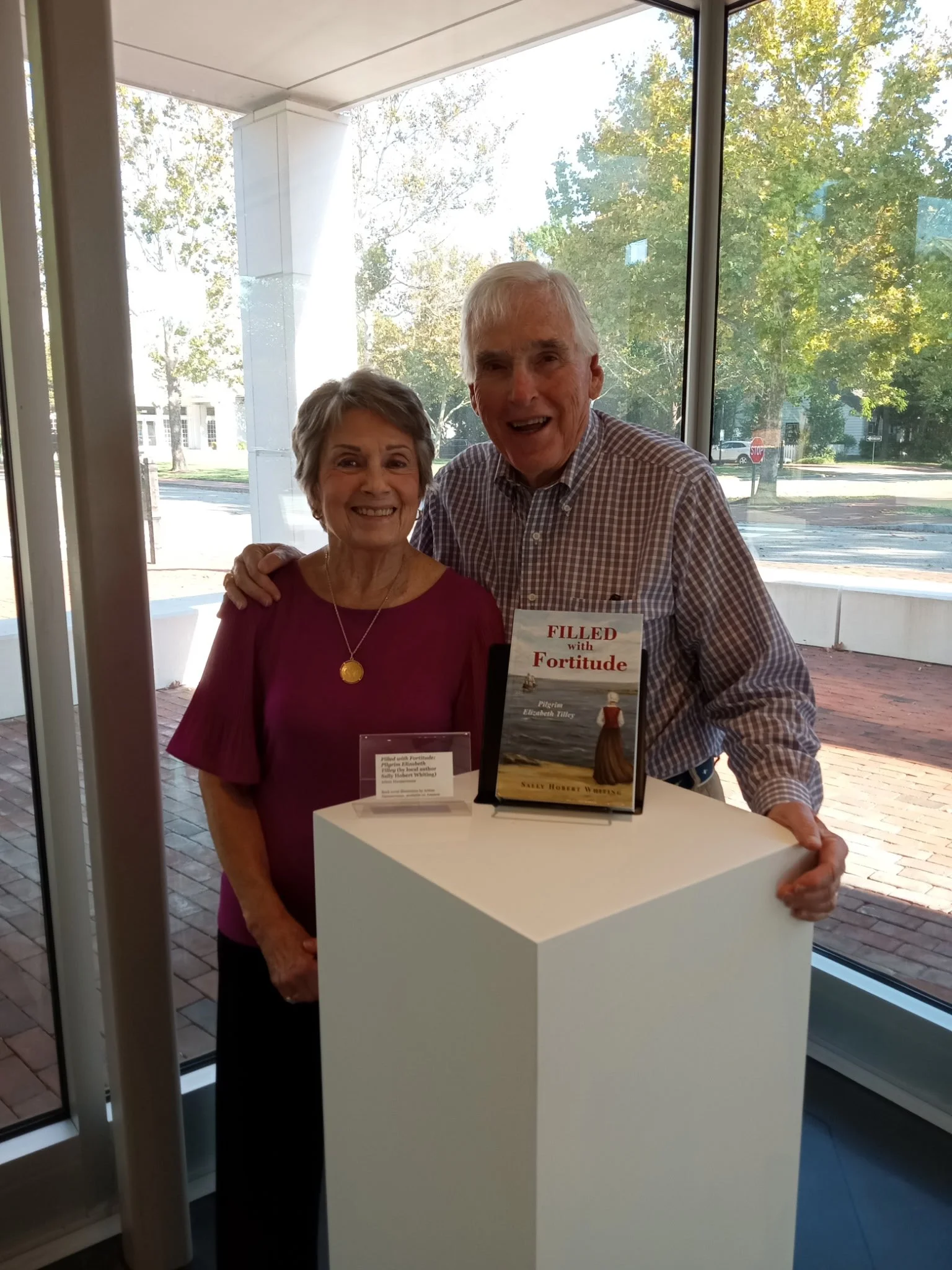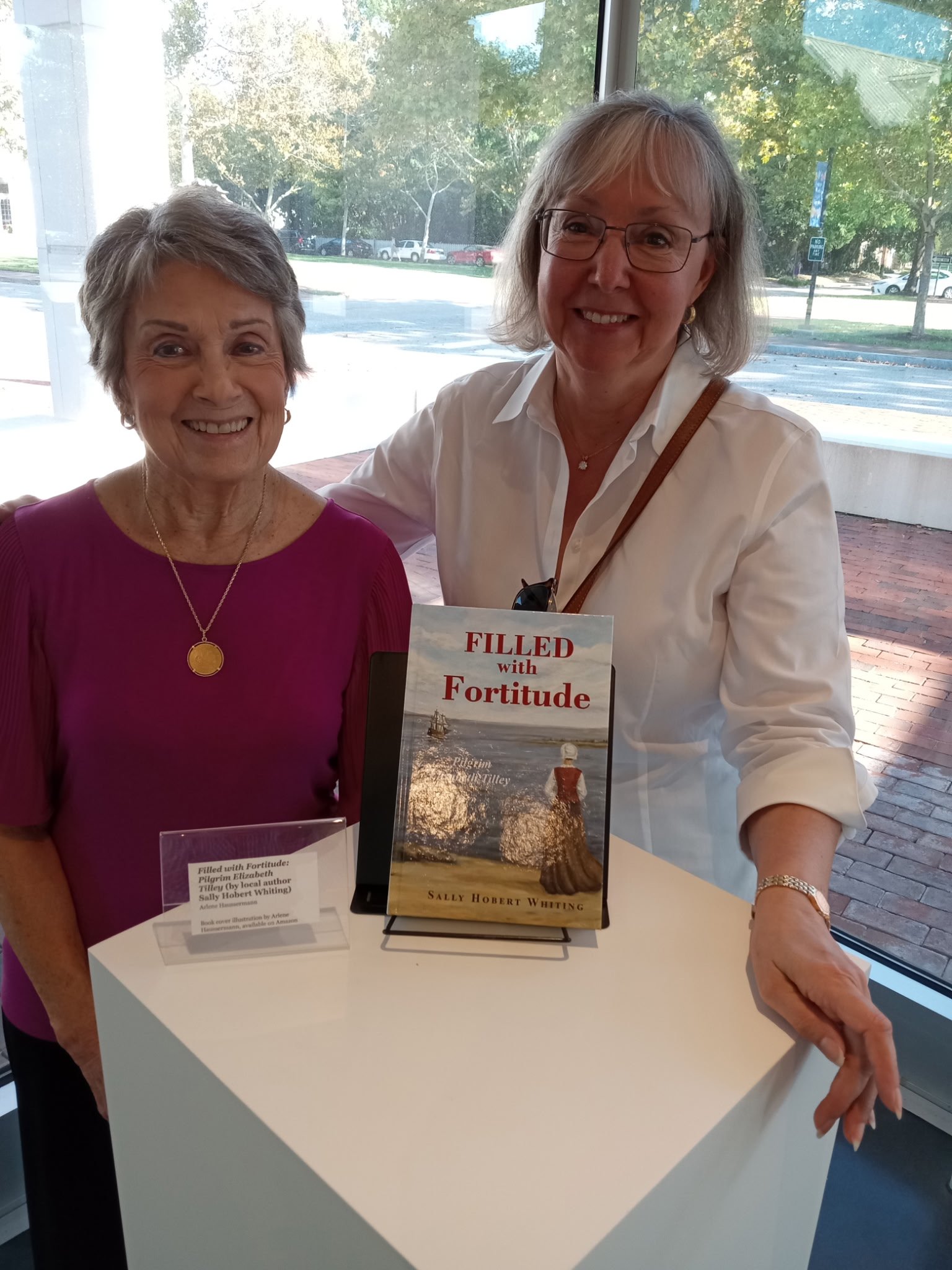Sally Hobert Whiting
In my debut historical novel, Filled with Fortitude, I draw from both historical research and my own life experiences to imagine the extraordinary journey of my ancestor, Elizabeth Tilley. Writing her story took six years and deepened my respect for the courage and resilience of all our Mayflower ancestors.
I believe their lives are worth rediscovering—and worth telling.
“I am proof it is never too late to do something you want to do, regardless of your age.”
— Sally Hobert Whiting

Sally and her husband Dave, a history enthusiast who inspired her interest in Plymouth Colony settlement.

Sally at the Mayflower Pub in London, one of the many stops in her research for Filled with Fortitude.

Sally with artist Arlene Haussermann, whose original oil painting appears on the cover of the book.

Sally with her newly published novel at Pilgrim Hall Museum in Plymouth, Massachusetts.
Six years of research, one unforgettable story—get your copy.
Bibliography
-
Ainsworth, Henry, The Pilgrim Psalter, Montgomery, Alabama: The Psalter Company, LLC, 2021.
Anderson, Robert Charles. The Great Migration Begins: Immigrants to New England, 1620-1633, Volumes I-III. Boston: New England Historic Genealogical Society, 1995.
Anderson, Robert Charles. The Mayflower Migration: Immigrants to Plymouth, 1620. Boston: New England Historic Genealogical Society, 2020.
Bangs, Jeremy Dupertuis. Strangers and Pilgrims, Travellers and Sojourners: Leiden and the Foundations of Plymouth Plantation. Plymouth, MA: General Society of Mayflower Descendants, Sheridan Press, 2009.
Banks, Charles Edward. The English Ancestry and Homes of the Pilgrim Fathers. Baltimore, Maryland: Genealogical Publishing Co., Inc., 2006.
Bartlett, Robert M. The Faith of the Pilgrims. New York/Philadelphia: United Church Press, 1978.
Boast, Mary. The Mayflower and Pilgrim Story: Chapters from Rotherhithe and Southwark. Southwark: Council of the London Borough of Southwark, 1995.
Bradford, William. Of Plimoth Plantation: The 400 th Anniversary Edition. Edited by Kenneth P. Minkema, Francis J. Bremer, and Jeremy D. Bangs. Boston: Colonial Society of Massachusetts and New England Historic Genealogical Society, 2020.
Bremer, Francis J. The Puritan Experiment: New England Society from Bradford to Edwards. Hanover, NH: University Press of New England, 1975.
Brown, Kathleen M. Foul Bodies: Cleanliness in Early America. New Haven & London: Yale University Press, 2009.
Culpepper, Nicholas. Complete Herbal. Bedford, Massachusetts: Applewood Books, originally published 1653.
Deetz, James. In Small Thins Forgotten: The Archeology of Early America Life. New York: Anchor Press/Doubleday, 1977.
Deetz, James and Patricia Scott. The Times of Their Lives: Life, Love, ad Death in Plymouth Colony. New York: W.H Freeman and Company, 2000.
Demos, John. A Little Commonwealth: Family Life in Plymouth Colony. New York: Oxford University Press, 1970.
Earle, Alice Morse. Colonial Dames and Good Wives. Boston and New York: Houghton, Mifflin & Company, 1895.
Fleming, Thomas J. One Small Candle: The Pilgrims’ First Year in America. New York: W. W. Norton & Company, Inc., 1963.
Germaine, Ron W. Improbable Connections: A Mayflower Story. Germaine Publishing, 2020.
Goodman, Ruth. How to be a Tudor: A Dawn-to-Dusk Guide to Tudor Life. New York and London: Liveright Publishing Corporation, 2015.
Hall, David D. The Puritans: A Transatlantic History. Princeton & Oxford: Princeton University Press, 2019.
Heath, Dwight B. (Editor). Mourt’s Relation: A Journal of the Pilgrims at Plymouth. Bedford: Applewood Books, 1963 (original text 1622).
Lynch, P.J. The Boy Who Fell Off the Mayflower or John Howland’s Good Fortune. Candlewick Press, 2015.
McIntyre, Debts Hopeful and Desperate: Financing the Plymouth Colony. Plymouth: Plymouth Plantation, 1963.
Marble, Annie Russel. The Women Who Came in the Mayflower. Columbia, SC: Read & Co., 2020.
Markham, Gervase. The English Housewife. Montreal & Kingston: McGill-Queen’s University Press, 1986.
Morgan, Edmund S. The Puritan Family: Religion and Domestic Relations in Seventeenth-Century New England. New York: Harper & Row Publishers, 1944.
Morton, Nathaniel. The New-England’s Memorial: A Brief Relation of the Most Memorable and Remarkable Passages of the Providence of God, Manifested to the Planters of New-England, in America. Plymouth: Reprinted by Allen Danforth, 1896.
Philbrick, Nathaniel. Mayflower: A Story of Courage, Community and War. New York: Viking Penguin Group, 2006.
Salisbury, Neal. Manitou and Providence: Indians, Europeans, and the Making of New England, 1500-1643. New York, Oxford: Oxford University Press, 1982.
Sherwood, Mary B. Pilgrim: A Biography of William Brewster. Falls Church, VA: Great Oak Press of Virginia, 1982.
Smith, Merril D. Women’s Roles in Seventeenth-Century America. Westport, CT: Greenwood Press, 2008.
Sommerville, C. John. The Discovery of Childhood in Puritan England. Athens and London: The University of Georgia Press, 1992.
Stoddard, Francis R. The Truth about the Pilgrims. Baltimore: Genealogical Publishing Co, Inc., 1976.
Treckel, Paula A. To Comfort the Heart. New York: Twayne Publishers, 1996.
Ulrich, Laurel Thatcher. Good Wives: Image and Reality in the Lives of Women in Northern New England 1650-1750. New York: Vintage Books, 1980.
Ulrich, Laurel Thatcher. A Midwife’s Tale. New York: Alfred A. Knopf, 1990.
Various authors. The Women of the Mayflower: A Collection of Excerpts Remembering the Women that History Forgot. Read & Co. History, 2020.
Willison, George F. Saints and Strangers. New York: Time Incorporated, 1945.
Winsor, Justin. History of the Town of Duxbury, Massachusetts with Genealogical Registers. Boston: Crosby & Nichols, 1849.
Young, Alexander. Chronicles of the Pilgrim Fathers of the Colony of Plymouth from 1602 to 1625. Boston: Charles C. Little and James Brown, 1841.

